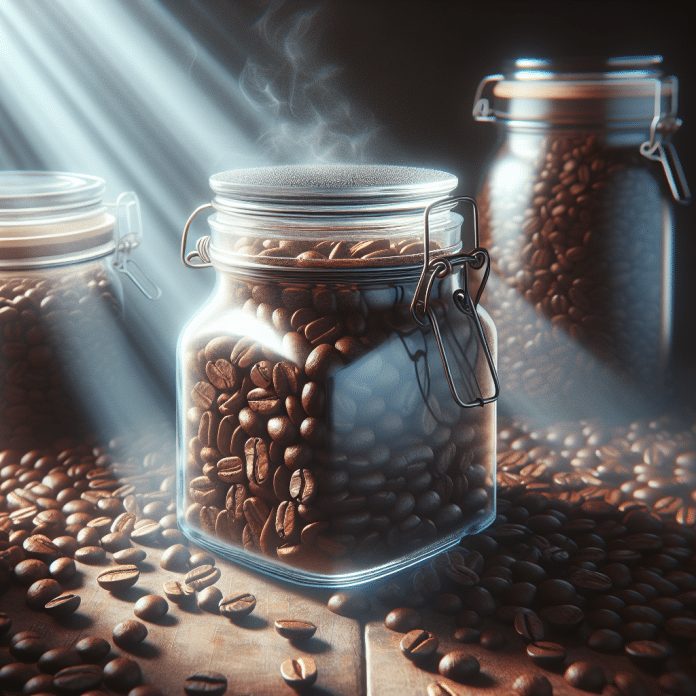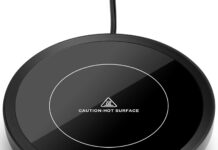Coffee storage is a crucial aspect of maintaining the freshness and flavor of your beans. With the right storage containers, you can ensure that every cup of coffee delivers a rich and aromatic experience. In this article, we explore the importance of proper coffee storage and discuss various types of containers that will keep your beans at their peak freshness. Whether you’re a coffee aficionado or simply enjoy a good cup of joe, this guide will help you make the most out of your coffee storage solution.
The Importance of Coffee Storage Containers
Preserving the Flavor and Aroma
As coffee enthusiasts, we understand the significance of preserving the delicious flavors and aromatic qualities of our favorite brew. By investing in a high-quality coffee storage container, we can ensure that each cup of coffee maintains its unique taste. The container plays a crucial role in protecting the delicate oils and flavors in coffee beans, preventing them from deteriorating and turning stale.
Preventing Oxidation
One of the biggest enemies of coffee freshness is oxidation. When coffee beans are exposed to oxygen, they begin to lose their flavor and become dull. This is why it is essential to store coffee in a container that provides a proper seal, preventing any air from entering and oxidizing the beans. By minimizing the contact between coffee beans and oxygen, we can prolong the freshness and flavor of our beloved beverage.
Avoiding Moisture Damage
Moisture is another factor that can significantly deteriorate the quality of coffee beans. When coffee beans absorb moisture, they can become moldy or damp, resulting in a loss of flavor and potentially harmful effects on our health. A good coffee storage container is designed to keep moisture out, ensuring that our coffee beans remain dry and free from any moisture-related damage.
Factors Affecting Coffee Freshness
Light Exposure
Exposure to light can have a detrimental impact on the freshness of coffee beans. The UV rays present in sunlight and artificial lighting can break down the compounds in coffee, leading to a loss of flavor and aroma. Choosing a coffee storage container made from an opaque material can shield the beans from light, preserving their freshness and preventing any degradation caused by light exposure.
Air Exposure
Just as exposure to light can damage coffee beans, contact with air can also have negative consequences. When coffee beans are exposed to oxygen, they undergo a process called oxidation, resulting in significant flavor deterioration. The ideal coffee storage container should provide an airtight seal, preventing any air from entering and preserving the freshness of the beans for a longer period.
Temperature Changes
Fluctuations in temperature can compromise the quality of coffee beans. Heat can accelerate the oxidation process, while cold temperatures can cause condensation and introduce moisture to the beans. It is crucial to store coffee in a cool and dry place, away from any sources of heat such as ovens or stovetops. By maintaining a consistent temperature, we can ensure that our coffee beans remain fresh and flavorful.
Characteristics of a Good Coffee Storage Container
Airtight Seal
To preserve the freshness of coffee beans, a coffee storage container must have an airtight seal. This ensures that no air can enter or escape, preventing oxidation and flavor deterioration. Look for containers with silicone gaskets or pressure lids that create a secure seal, keeping the oxygen out and the aroma locked in.
Opaque Material
As mentioned earlier, light exposure can negatively affect the quality of coffee beans. Therefore, it is important to choose a storage container made from an opaque material. This will help to block out any sources of light and protect the beans from harmful UV rays, ensuring that their flavor and aroma remain intact.
UV Protection
In addition to an opaque material, some coffee storage containers offer additional UV protection features. These containers are specifically designed to block out UV rays, which can cause degradation and spoilage of the beans. Consider investing in a container with built-in UV protection if you plan to store your coffee in a room with ample sunlight or if the container will be exposed to artificial lighting.
Size and Capacity
When selecting a coffee storage container, it is important to consider the size and capacity that suits our needs. Opting for a container that is slightly larger than the amount of coffee we typically consume allows us to store the beans in their original packaging, preserving their freshness. Avoid containers that are too large, as this can lead to increased air exposure when the container is only partially filled.
Easy to Open and Close
Convenience is another important factor when choosing a coffee storage container. We want a container that is easy to open and close, ensuring quick access to our coffee beans without compromising the freshness of the remaining contents. Look for containers with user-friendly mechanisms such as flip-top lids or snap-lock seals, allowing for effortless usage.
Different Types of Coffee Storage Containers
Ceramic Canisters
Ceramic canisters are a popular choice for coffee storage due to their aesthetic appeal and ability to maintain the freshness of coffee beans. These canisters provide excellent insulation, protecting coffee beans from temperature changes and light exposure. Ceramic containers are often designed with airtight lids and offer a wide range of sizes and styles to suit different preferences.
Glass Jars
Glass jars are another visually appealing option for storing coffee beans. They offer the advantage of being transparent, allowing us to see the beans while still providing some protection from light when stored in a pantry or cupboard. Glass jars with airtight seals are effective in preserving the flavor and aroma of coffee beans. However, it is important to keep in mind that glass jars may not provide the same level of insulation as other materials.
Stainless Steel Containers
Stainless steel containers are a practical choice for coffee storage, as they offer durability and excellent insulation properties. These containers are often designed with airtight lids, preventing air and light from entering. Stainless steel is resistant to moisture and odor absorption, making it an ideal material for preserving the freshness of coffee beans. Additionally, these containers are easy to clean and maintain.
Vacuum Sealed Canisters
Vacuum sealed canisters are specifically designed to remove excess air, ensuring optimum freshness and longevity for coffee beans. These containers utilize a vacuum pump to extract air from the canister, creating a seal that prevents oxidation and flavor degradation. The vacuum-sealing process helps to retain the full flavor and aroma of the coffee beans, allowing us to enjoy a rich and satisfying cup of coffee every time.
Pros and Cons of Each Container Type
Ceramic Canisters
Pros:
- Aesthetic appeal adds to kitchen decor
- Excellent insulation properties
- Versatile range of sizes and styles
Cons:
- Can be fragile and prone to breakage if mishandled
Glass Jars
Pros:
- Transparent, allowing easy visibility of beans
- Airtight seals preserve freshness
- Wide availability and variety of shapes and sizes
Cons:
- Limited protection from light exposure
Stainless Steel Containers
Pros:
- Durable and long-lasting
- Excellent insulation and moisture resistance
- Easy to clean and maintain
Cons:
- Lack of transparency makes it difficult to see the beans inside
Vacuum Sealed Canisters
Pros:
- Removes excess air, preserving freshness
- Protects beans from oxidation and moisture
- Extends the shelf life of coffee beans
Cons:
- Requires the use of a vacuum pump for sealing
Tips for Proper Coffee Storage
Use Freshly Roasted Beans
To maximize the flavor and aroma of our coffee, always aim to use freshly roasted beans. Coffee beans are at their peak freshness within two to four weeks of being roasted. Purchasing smaller quantities of beans that can be consumed within this timeframe ensures that we are enjoying coffee at its best.
Keep Away from Heat Sources
Heat is a coffee bean’s worst enemy, as it accelerates the oxidation process and compromises the quality of the beans. Avoid storing coffee near heat sources such as ovens, stovetops, or direct sunlight. Instead, find a cool and dry spot, such as a pantry or cupboard, that maintains a consistent temperature.
Avoid Freezing Coffee
Contrary to popular belief, freezing coffee is not recommended as it can negatively impact the flavor and texture of the beans. The moisture in the freezer can cause condensation on the coffee beans, leading to potential flavor loss and damage. It is best to store coffee at room temperature.
Store in Small Portions
To ensure the freshest cup of coffee every time, store coffee in small portions. Dividing coffee beans into smaller quantities minimizes the amount of air and light exposure each time the container is opened. This practice helps to preserve the flavor and aroma of the remaining beans for an extended period.
Frequently Asked Questions (FAQs)
Can I reuse coffee bags for storage?
It is not recommended to reuse coffee bags for long-term storage. Coffee bags are typically designed with a one-way valve that allows the release of carbon dioxide while preventing air from entering. After the bag is opened, it is difficult to achieve a proper seal, exposing the beans to air and diminishing their freshness. Investing in a dedicated coffee storage container will help maintain the quality of the beans.
What is the ideal temperature for coffee storage?
The ideal temperature for coffee storage is between 50°F and 70°F (10°C and 21°C). It is important to avoid extreme temperature fluctuations, as they can affect the flavor and aroma of the coffee beans. Storing coffee in a cool and consistent environment will help preserve its freshness for a longer period.
How long can coffee be stored?
Coffee can be stored for different lengths of time depending on various factors. Whole coffee beans can typically be stored for up to three to four weeks after the roast date, while ground coffee has a shorter shelf life of one to two weeks. To ensure the best possible flavor, it is recommended to consume coffee within these time frames.
Should I store coffee in the refrigerator?
Storing coffee in the refrigerator is generally not recommended. The refrigerator can introduce moisture and odors that can adversely affect the taste and freshness of the coffee. Additionally, temperature fluctuations that occur when taking the coffee in and out of the refrigerator can impact the quality of the beans. It is best to store coffee in a cool and dry pantry or cupboard.
Conclusion
Investing in a high-quality coffee storage container is essential for any coffee lover who wants to preserve the flavor and aroma of their favorite brew. By understanding the factors that can affect coffee freshness and selecting the right container, we can ensure that our coffee beans remain fresh, flavorful, and enjoyable for a prolonged period. Whether we choose ceramic canisters, glass jars, stainless steel containers, or vacuum-sealed canisters, following proper storage guidelines will help us enjoy a consistently delicious and satisfying cup of coffee every time. So, let’s take the necessary steps to keep our beans fresh and savor the true essence of coffee.






































